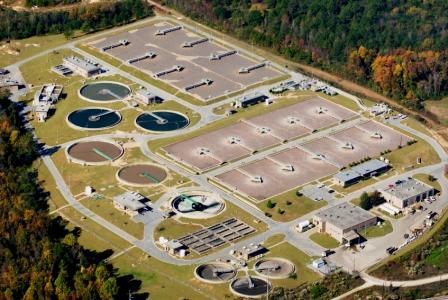Waste Water Treatment
The aim of waste water treatment is to make it cleaner so that it can either be discharged back to the surrounding environment without damaging existing environmental quality or it can be used for different beneficial purposes. Currently different physical, chemical and biological processes and process units are grouped together to provide various levels of treatment to waste water. Following are brief discussions on these waste water treatment processes-

A waste water treatment plant.
Waste Water Treatment Processes:
Waste water treatments usually include a series of physical, chemical and biological processes.
Physical Treatment Processes:
In physical treatment process, no major chemical or biological changes are carried out and strictly physical forces are used to improve or treat the waste water. Usually physical treatment processes are used to remove large debris, floatables and solids from waste water. List of some physical treatment processes are:
- Screening
- Sedimentation (Clarification)
- Filtration
- Flotation and Skimming
- Flow Equalization
Chemical Treatment Processes:
Chemical treatment processes use chemicals and chemical reactions to remove waste water pollutants. A Chemical may change the structure and properties of a pollutant that later becomes easier to be removed by other physical processes. Like adding alum or synthetic polymer to Waste water helps to flock phosphorus, that is later removed through sedimentation or filtration process. Adding chlorine to waste water is another example of chemical treatment processes that kills pathogenic organism and make the waste water safe to discharge. Example of some chemical treatment processes are:
- Chlorine Disinfection
- Ozonation
- pH Neutralization
- Coagulation
- Adsorption
- Ion Exchange
Biological Treatment processes:
Biological treatment processes use microorganisms, mostly bacteria to consume organic matter and create new bacterial cells, carbon dioxide and other by products. Based on availability of dissolved oxygen, biological processes can be divided into anaerobic or aerobic processes. The excess biological growth or sludge generated during biological processes can later be removed through a physical treatment process. Example of some biological treatment processes are:
- Activated Sludge
- Extended Aeration
- Sequencing Batch Reactor
- Membrane Bioreactor
- Anaerobic/ Aerobic Digestion
- Septic Tanks
- Lagoons
Effluent Disinfection:
Treated waste water effluent should be disinfected before releasing back to the environment. Effluent disinfection can be done using several different methods and most common ones are chlorine, ozone or ultraviolet (UV) technology.
Digestion Tank and other Auxiliary Sludge Treatment and Disposal Processes:
Sludges collected from both primary and secondary
sedimentation tank are further treated using digestion technology commonly in
an anaerobic environment (without the presence of oxygen). In this process
sludge is held inside the digester for 10 to 20 days at around 37 0C
to break down and destroy the organic matter of the sludge. This process also
creates biogas, mainly a mixture of methane and carbon dioxide gas. Biogas can
be used to several beneficial purposes and most common ones are to produce
heat, electricity and fuel. The semi-liquid material produce from the digestion
process can be dried further and used for different beneficial purposes such as
fertilizers, land applications,
nutrients recovery etc. or transported to landfill.
Go back to the Water Pollution Home!
Go back to The EcoAmbassador Home!
Know more details on waste water treatment here.
Total Visits to Site: